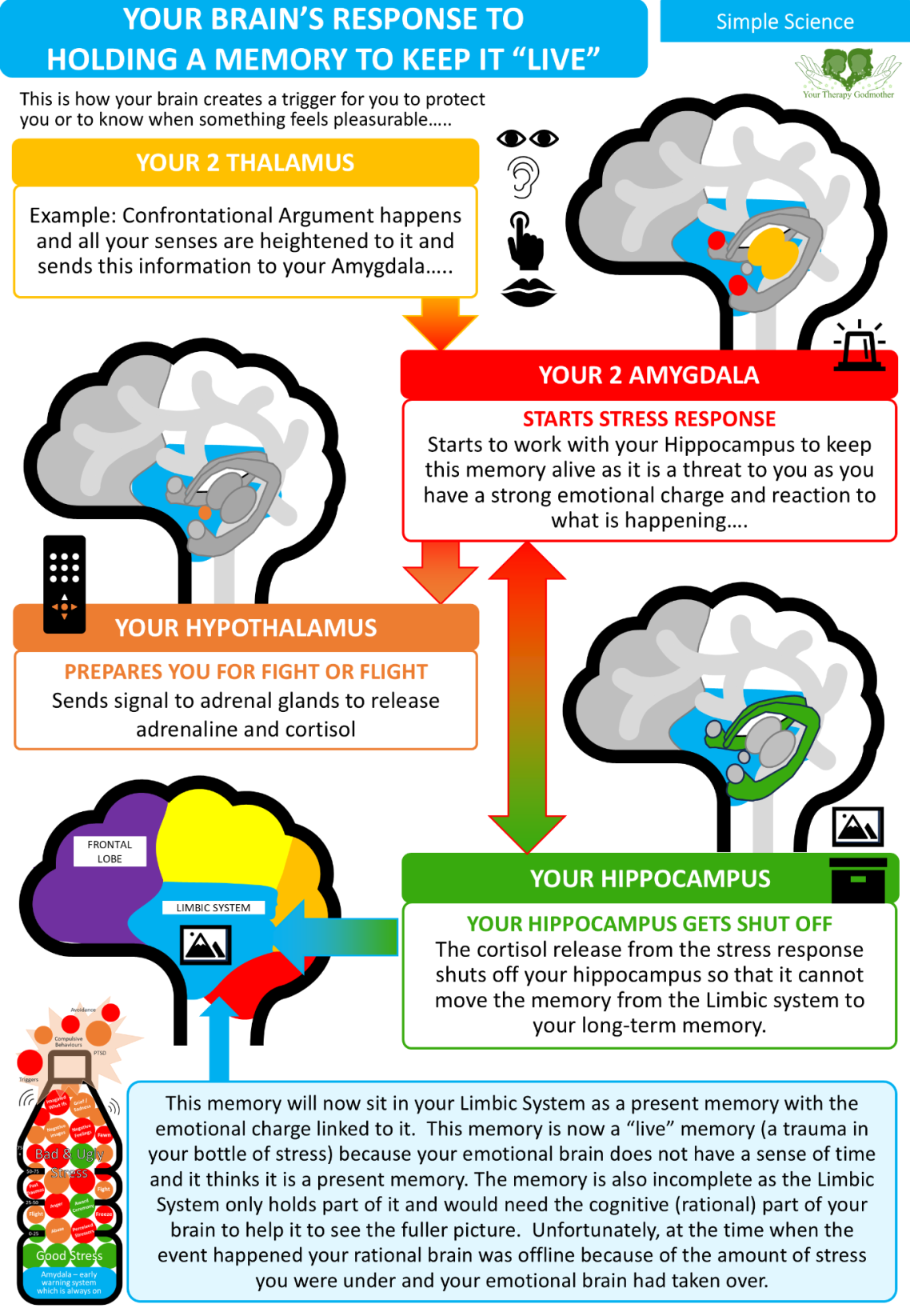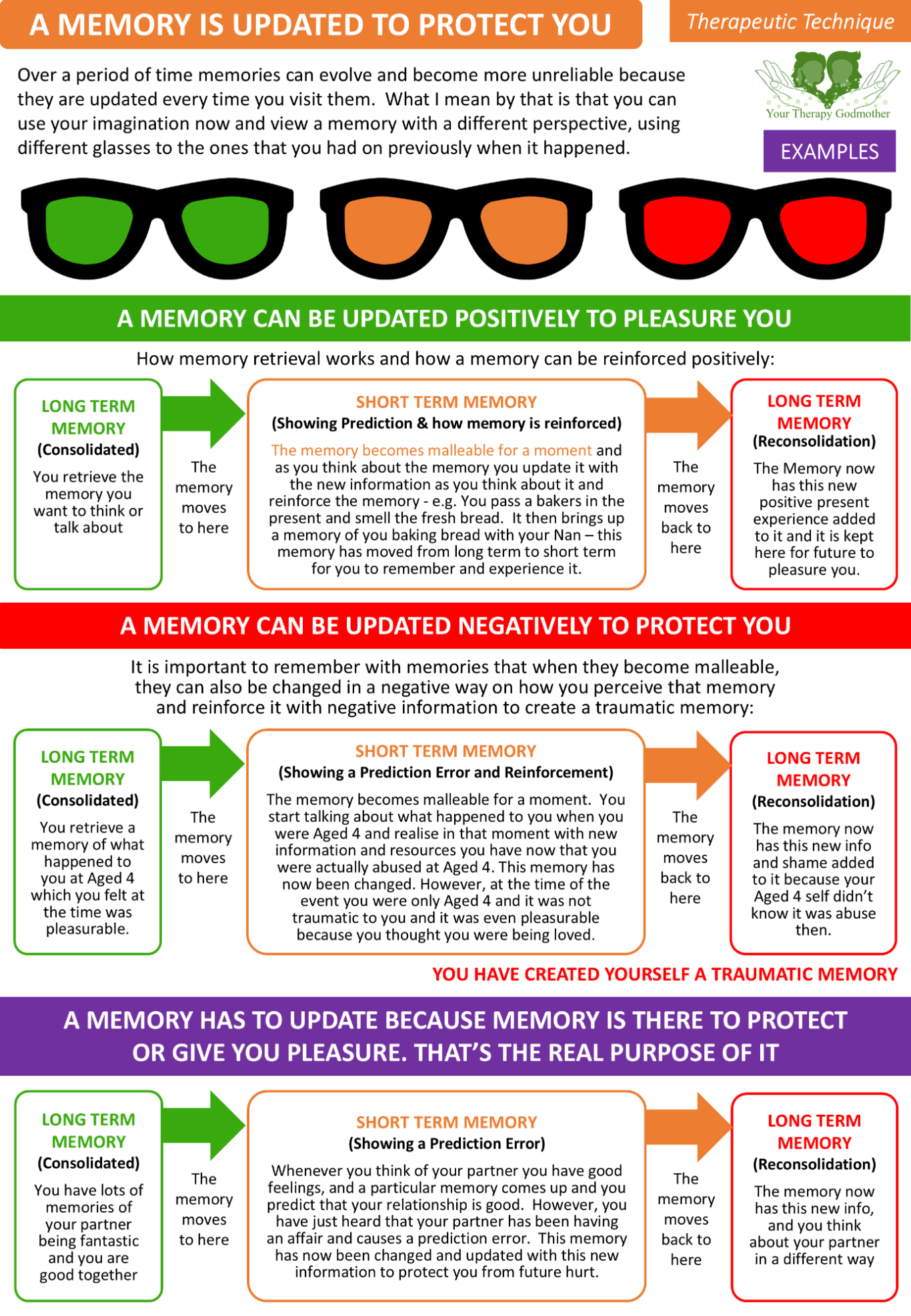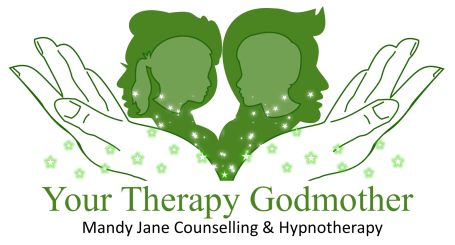Resolving Traumatic Memories.....

Traumatic memories you have live in the brain (with trapped emotions in the body) and are stored differently in the way that your usual memories are. Your usual memories can be filed neatly into your timeline of life stories; they all have a suitable place, time, and context to them, and they remain the same size and can be remembered with a positive emotion, feeling, thought or sensation attached to them. For traumatic memories however they will stand out more and will not be as filed as neatly away on your timeline of life stories as they have not been date stamped. This is because they have that negative emotion, feeling, thought, image, sensations or beliefs attached to them which can be triggered by your conscious self.
For example: You have created a photo album of memories since your birth and all of them photos have been kept in date order and they have positive memories attached to them. However, you notice some photos are bigger, these are the traumatic memories you have and they have negative emotions attached to them. The negative experiences you endured at the time of the trauma have created these traumatic photos which are bigger. They may also be blurry or covered up in order to protect you from seeing their content. This is normally how your subconscious will protect your conscious from seeing them so that you are not hurt by them.
These traumatic memories/photos become lessons, decisions/core beliefs that we have now created. Our traumatic experiences only become trauma when our fight or flight senses try to protect us from a dangerous and frightening event, and it fails. For example: when a police officer sees a friend die and they can’t save them; when we want to run away but we are trapped; when someone holds you down and you cannot free yourself from underneath them; when a ceiling comes down over you and you are stuck. Your fight or flight survival instinct has failed, it jams and freezes at that time with all the emotions, feelings and senses within it and it becomes a traumatic memory in your photo album.
This means that nothing can be trusted in the same way. You now see most things as a threat. If you are traumatised, you become ‘hyper-vigilant and are now in constant watch for danger. This trauma will now live within your unconscious and your conscious brain will find it difficult to dig deep enough to touch or access it. You will not be able to stop the triggers from starting because they are emotionally charged from the subconscious and traumatised memory and unfortunately your conscious and logical brain cannot reach that far.
If you live with the trauma you will only be able to have a fraction of control of your symptoms (such as irritableness, anxiety, insomnia, high tension, etc.) and learn some techniques such as distractions, coping as a way of managing them. For example, You start breathing through a panic attack because someone has looked at you although you are unable to actually stop the panic attack from happening in the first place.
Because you are constantly on high alert and looking out for danger it can be very exhausting as it doesn’t allow you time to rest. It can then start to affect your mind and body and you become constantly at its mercy because you now experience bad and ugly stress and you have hyper-arousal or hypo-arousal states / stress responses. Therefore traumatic memory can be seen as a thick branch stuck in a stream of our life stories. These life stories can no longer flow forward as they did before the trauma.
To help your Jenga Life Tower to remain upright, even if wobbling, it is important to explore, identify and process those intense negative thoughts, images, emotions, sensations and beliefs attached to the traumatic memory that are often called trapped emotions. I have a variety of different techniques that can assist you in breaking down, resolving, and removing the emotion from these branches such as:
- Gestalt Therapy and Creative Work through Counselling / Talking Therapy
- Hypnotherapy
- Eye Movement Desensitisation Reprogramming (E.M.D.R.)
- Re-Parenting Childhood Traumas using Inner Child Therapy
- Matrix Re-imprinting and Emotional Freedom Techniques
The problem is never the problem.
It is the way that you are dealing with the problem.
That is the problem.
In order to avoid that traumatic memory, you may have decided to put so many different negative strategies and rules in place to stop you feeling it, hearing it, seeing it even tasting it or smelling it. These may be unhealthy coping strategies such as drinking, over-eating, over-working and addictions, etc to avoid, escape or numb the distressing feelings, images, thoughts, emotions and sensations it causes you from that traumatic memory. The problem however will putting these unhealthy strategies in place is that now it will be causing you to numb all your feelings, even the positive ones such as happiness, joy, etc. The brain cannot differentiate between negative (uncomfortable) or positive (comfortable) emotions, all it knows is that you use a behaviour of drinking, over-eating whenever you have a emotion and over time it will stop you feeling anything, you will feel so numb and will then cause you more problems and stress.
So, by avoiding the feelings, thoughts, images, emotions and sensations around that traumatic memory you have unfortunately inadvertently caused yourself some Post Traumatic Stress (PTS) and these traumatic memories keep on triggering you with those thoughts, smells, sounds, sensations, images and emotions attached to that traumatic memory.
This then adds and fills up your bottle of stress and reinforces your feelings of fear around that traumatic memory.
Also, it is worth remembering that every time you imagine a memory you are reinforcing and embedding it in more into your limbic system to become stronger and stronger as a memory whether it is a positive one or a negative one.

